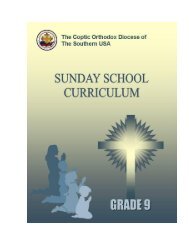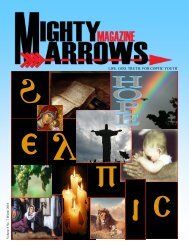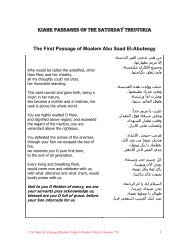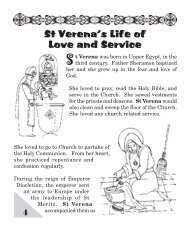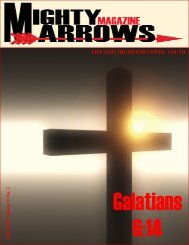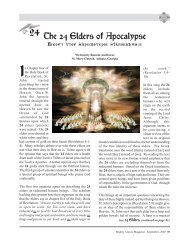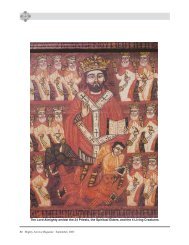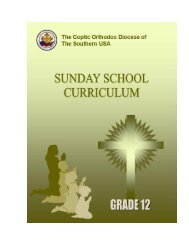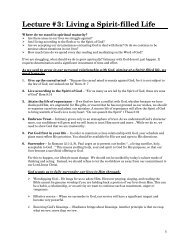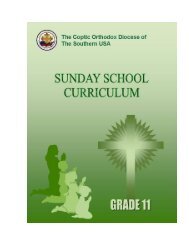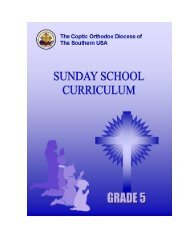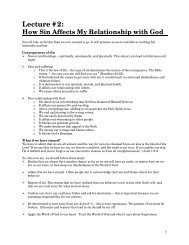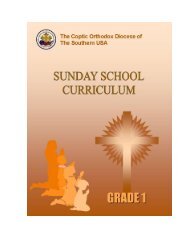Grade 10 - Coptic Orthodox Diocese of the Southern United States
Grade 10 - Coptic Orthodox Diocese of the Southern United States
Grade 10 - Coptic Orthodox Diocese of the Southern United States
You also want an ePaper? Increase the reach of your titles
YUMPU automatically turns print PDFs into web optimized ePapers that Google loves.
Sunday School Curriculum <strong>Grade</strong> <strong>10</strong><br />
3. Nestorianism<br />
Nestor was <strong>the</strong> Bishop <strong>of</strong> Constantinople. He began teaching that it is wrong to call <strong>the</strong><br />
Virgin Mary ―<strong>the</strong> Theotokos‖ meaning <strong>the</strong> Mo<strong>the</strong>r <strong>of</strong> God. He claimed that St. Mary was only<br />
<strong>the</strong> mo<strong>the</strong>r <strong>of</strong> <strong>the</strong> man Jesus and he denied <strong>the</strong> divinity <strong>of</strong> Christ. The news <strong>of</strong> this heresy<br />
reached Alexandria by spring <strong>of</strong> AD 429. St. Cyril began to denounce this <strong>the</strong>ology without<br />
mentioning names. Nestor rebuked St. Cyril for his criticism and outspokenness.<br />
St. Cyril began exchanging letters with Nestor: first letter asked him to acknowledge <strong>the</strong> title<br />
<strong>of</strong> <strong>the</strong> Virgin Mary ―Theotokos‖. The second letter challenged <strong>the</strong> Christology <strong>of</strong> Nestor by<br />
using <strong>the</strong> words <strong>of</strong> <strong>the</strong> Nicene Creed: ―God was incarnate and became man‖. Third letter again<br />
used <strong>the</strong> words <strong>of</strong> <strong>the</strong> Nicene Creed to explain in detail what he meant by <strong>the</strong> belief in <strong>the</strong> one<br />
nature <strong>of</strong> <strong>the</strong> Incarnate Word and appended twelve ana<strong>the</strong>mas. He asked Nestor to sign<br />
ana<strong>the</strong>mas to prove his <strong>Orthodox</strong>y, and Nestor refused to sign and responded with twelve<br />
ana<strong>the</strong>mas <strong>of</strong> his own. These letters were circulated throughout <strong>the</strong> Christian world and St.<br />
Cyril explanations were widely accepted and praised. St. Cyril held a local council in<br />
Alexandria to discuss <strong>the</strong> issue, and decided to add <strong>the</strong> Introduction to <strong>the</strong> Creed: ―We magnify<br />
you, <strong>the</strong> Mo<strong>the</strong>r <strong>of</strong> <strong>the</strong> True Light...‖.<br />
At Ephesus<br />
Emperor Theodosius called for a general council to meet in Ephesus (modern day Turkey) in<br />
AD 431. The Pope arrived with 50 <strong>of</strong> his bishops and some monks. Delegates <strong>of</strong> Asia,<br />
Jerusalem and later Rome all supported St. Cyril‘s definition. Nestor also arrived to <strong>the</strong> city<br />
but refused to attend <strong>the</strong> meetings. They decided to excommunicate Nestor. When <strong>the</strong><br />
decision was announced to <strong>the</strong> people <strong>of</strong> Constantinople, <strong>the</strong>y rejoiced.<br />
III. Titles<br />
Titles given to St. Cyril are: ―The Second Athanasius‖, ―The Daring Lion‖, ―The Great‖, ―The<br />
Pillar <strong>of</strong> <strong>the</strong> Faith‖, and ―The Defender <strong>of</strong> <strong>Orthodox</strong>y‖.<br />
IV. Legacy and Works<br />
A. Scriptural commentaries<br />
Pentateuch, Isaiah, <strong>the</strong> twelve minor prophets, fragments <strong>of</strong> Kings, Psalms, Proverbs, Song <strong>of</strong><br />
Songs, Jeremiah, Ezekiel and Daniel, St. John, St. Luke, fragments <strong>of</strong> Mat<strong>the</strong>w, Romans,<br />
Hebrews and First and second epistles to <strong>the</strong> Corinthians.<br />
B. Festal letters<br />
Twenty-nine letters were written between AD 414 - 442.<br />
C. Sermons<br />
Twenty-two sermons remain.<br />
D. Books<br />
Some <strong>of</strong> <strong>the</strong> books written by St. Cyril were about why we should be against pagans and <strong>the</strong><br />
Arians. He also wrote doctrinal topics; such as, On <strong>the</strong> Holy and Con substantial Trinity and<br />
on <strong>the</strong> Unity <strong>of</strong> Person in Christ.<br />
E. Liturgy<br />
Originally written by St. Mark, but arranged by St. Cyril, oldest Liturgy in <strong>the</strong> <strong>Coptic</strong> Church.<br />
Conclusion:



